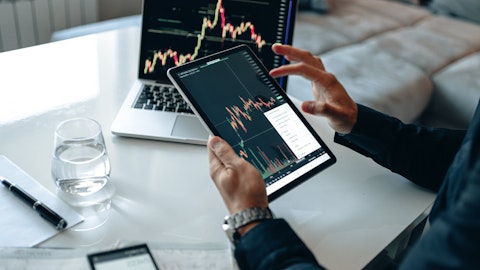Neil Mehta: Yes. Thanks so much. The first question is just, sort of, the M&A environment. To the extent the market choppiness continues. You guys have done a great job being countercyclical in picking up assets and recognizing you have no gaps in your portfolio, but do you see an opportunity to be proactive in countercyclical to the extent these conditions worsen?
Tim McKay: Yeah. It’s a really good question, Neil. And if you look at our track record, it’s really been all about when we do an M&A, it’s about how much value — long-term value does that acquisition had. So, it’s really not even about countercyclical. It’s really about what value can we achieved through that acquisition. So that’s really all I can say is, we’re not in the market, but any acquisition we do. And you’ve seen it in the past is, how much incremental value? Does it create long-term for our shareholders?
Neil Mehta: Okay. That makes sense. The follow-up is just on some of the pipeline movements here and updates that have been pretty active in the last couple of weeks. So, the first one would be around the mainline. And do you think that the pending agreement has the potential to tighten up WCS differentials. And then, as it relates to TMX, any of the cost of runs here, how much of it do you see as being potentially pushed through on to the suppliers? Thank you.
Mark Stainthorpe: Okay. Thanks, Neil. Two very good questions, first, on the Enbridge one, it’s difficult to say. I think, what’s positive is the parties have put together and agreed on a fair tolling agreement. So we’ll see what that does. I think in just general, having more egress available is really the driving force before differentials. In terms of TMX, we’re a committed shipper on there for 94,000 barrels a day and no different than Enbridge. You go through the process to make sure the cost and the toll piece is correct for that service. So it’s to me, it’s just no different than Enbridge, you have to step through that process to understand the cost and what is allocated to lead into the goals.
Neil Mehta: Make sense.
Operator: Your next question comes from Menno Hulshof from TD Securities. Please go ahead.
Menno Hulshof: Thanks and good morning everyone. I just have one question on IPEP, especially given some of the negative press on tailings ponds of late. Can we get an update on the time line for getting the demonstration plant up and running? And then realistically, when can we expect it to be deployed commercially? And then maybe you could also speak to whether you’re fully committed to moving IPEP and PFT forward together at this stage.
Tim McKay: Yeah. Those are good questions. Those are for IPEP, we’d still have to do another more commercial size demonstration path. So IPEP is a great opportunity. But from the work that we’ve been doing in the background, our engineers believe that if you were to do IPEP, then you would need to do really something else like paraffinic and actually do two items at the same time because it is a large cost to go that way. In terms of tailings, I mean, — we have a very good program. We have a very robust group out there, making sure that our trialing are compliant. So, to me, it’s — as always, I mean, we’re always looking for opportunities to continually improve our environmental performance, whether it’s in water, tailings, GHG. And we have a great team of engineers and people working in our Technology Innovation group that are looking at all the opportunities that we can do to reduce our environmental footprint everywhere in the company.
: : Thanks, Tim. That’s all I had.
Operator: Presenters, there are no further questions at this time. Please proceed with your closing remarks.
Lance Casson: Thank you, operator, and thank you for joining us this morning. If you have any follow-up questions, please give us a call. Thanks, and have a great day.
Operator: Ladies and gentlemen, this concludes your conference call for today. We thank you for joining and ask that you may disconnect your lines. Thank you.
Follow Canadian Natural Resources Ltd (NYSE:CNQ)
Follow Canadian Natural Resources Ltd (NYSE:CNQ)
Receive real-time insider trading and news alerts





